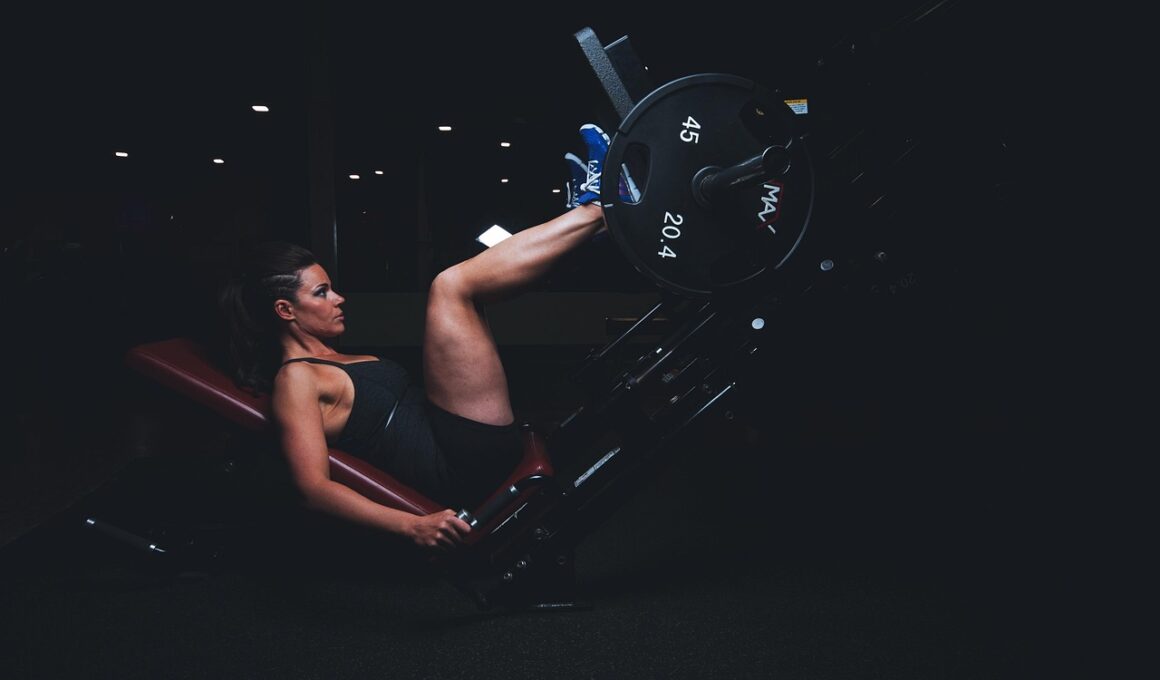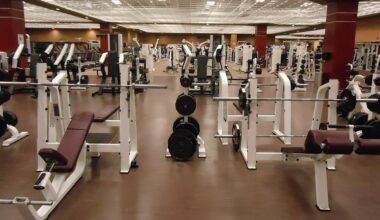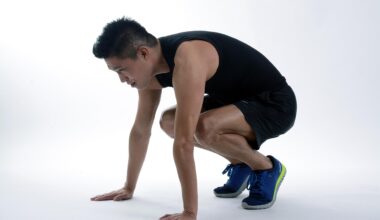Strength and Conditioning Workouts Without Gym Equipment
Strength and conditioning workouts are essential for boosting athletic performance and overall health. Engaging in bodyweight exercises offers a fantastic opportunity to strengthen muscles without any need for gym equipment. These workouts can be performed almost anywhere, whether at home, in the park, or at the beach. This flexibility allows anyone to maintain a consistent exercise routine. Proper strength and conditioning not only improves muscle mass but also enhances endurance, stability, and overall agility. It helps in injury prevention, making your body more resilient to risks. Moreover, these workouts challenge multiple muscle groups, leading to a functional level of strength that you can apply in daily life. Whether you are a seasoned athlete or just a fitness enthusiast, these workouts can cater to your needs for all fitness levels. With exercises like push-ups, squats, lunges, and planks, the combinations are simply endless. Utilizing your weight creates resistance, effectively building strength. Always remember to warm up before starting any workout routine to avoid injuries and maximize performance outcomes.
When considering the effectiveness of strength training, numerous bodyweight exercises come to the forefront. Here are a few foundational movements you can include, targeting various muscle groups to create a comprehensive workout plan. First on the list is the push-up, which primarily targets the chest, shoulders, and triceps. To execute this, start in a plank position, performing the movement by lowering and raising your body. Next, consider squats, which focus on your legs and core. Stand with feet shoulder-width apart, lowering your body as if sitting back into a chair. Lunges are another excellent exercise that works the thighs and glutes, ensuring balanced development. Planks engage the entire core, promoting stability. Finally, jumping jacks serve as a great cardiovascular boost, merging agility and strength effectively. To improve your workout, incorporate variations for each exercise, such as single-arm push-ups or sumo squats. This variation keeps your routine fresh and can challenge you further, helping to break through any plateau. Before you start, make sure to assess your fitness level and adjust the number of repetitions as necessary for your progress.
Creating a Balanced Routine
For optimal results, designing a balanced strength and conditioning routine is vital. One of the critical elements to consider is the principle of progression. Gradually increasing the difficulty level of your workouts ensures continuous improvement and avoids stagnation. Start by determining the exercises that you enjoy, as enjoyment is crucial for consistency. A typical routine might involve three to five sets of each exercise, which can be mixed and matched based on your schedule and time availability. Additionally, ensure to balance the focus between upper body, lower body, and core exercises. The inclusion of multi-joint movements can maximize efficiency, engaging more than one muscle group simultaneously. Aim to include strength workouts at least two or three times weekly, allowing enough recovery time to promote muscle growth. Every session should integrate flexibility and mobility work to maintain a full range of motion. While consistency is key, don’t overlook the importance of rest days, which are equally vital for muscle recovery. Finally, staying hydrated and mindful of nutrition will further enhance your overall performance and recovery.
Incorporating mobility and flexibility exercises can greatly enhance your strength and conditioning program. Individuals often underestimate the significance of these components, yet they play a crucial role in injury prevention and recovery. Stretching should be integrated both before and after workouts to prepare your muscles. Dynamic stretches serve as an excellent warm-up, while static stretches help cool down. Try incorporating movements like leg swings, arm circles, or torso twists as part of your warm-up. Post-workout, considering sequences to address major muscle groups enables overall muscle relaxation. For instance, quadriceps stretches or hamstring stretches can be beneficial after lower body workouts. Yoga can also serve as a perfect complement to your strength regimen, encouraging flexibility, balance, and mental calmness, helping with recovery periods. Setting a dedicated time each week for these exercises can aid in enhancing performance and sustaining injury-free progress. Moreover, mindfulness practices like deep breathing during stretching can amplify the benefits to both physical and mental wellness, ultimately contributing to a successful fitness journey. Remember, every aspect of fitness is interconnected and should be treated as such within your routine.
The Role of Nutrition
Nutrition plays a critical role in supporting your strength and conditioning workouts. Focusing on a balanced diet not only fuels your body but also aids in recovery and muscle growth. A diet rich in proteins, complex carbohydrates, and healthy fats offers the necessary nutrients that enhance performance. Proteins serve as the building blocks for muscle tissues, hence consuming lean meats, fish, legumes, or plant-based sources is essential. Incorporating whole grains, such as brown rice or quinoa, can provide sustained energy throughout your workouts. Furthermore, healthy fats found in avocados, nuts, and seeds play a crucial role in hormone production, inflammation reduction, and energy support. Hydration, too, cannot be neglected; water is vital for overall bodily functions. Try to consume water consistently throughout the day, particularly before, during, and after exercising. Additionally, consider pre and post-workout meals or snacks, which can further boost performance and recovery; options like bananas or protein shakes work perfectly. Understanding that nutrition is personal and varied based on individual needs can lead you to make informed choices that will enhance your fitness journey.
The mental aspect of strength and conditioning should not be overlooked. A positive mindset can significantly influence your workout experience and outcomes. Approach your workouts with a focus on goals and achievements. Setting achievable, short-term goals can help maintain motivation and provide a sense of accomplishment. Visualizing your success with each workout can create a stronger mind-muscle connection, enhancing your performance effectiveness. Consider journaling your workouts, allowing you to track progress, celebrate milestones, and adjust your routine accordingly. This reflection often creates an empowering environment in which you can thrive. Another crucial aspect is embracing the challenges that come with fitness; acknowledge that growth often emerges from discomfort. Engaging in mindfulness practices, like meditation or deep breathing exercises, can further strengthen your mental resilience and focus. Don’t hesitate to seek a workout buddy or join a community, whether in person or online; sharing your journey fosters camaraderie and collective encouragement. Ultimately, the journey towards improved strength and conditioning is both physical and mental, creating a holistic approach that will yield lasting results.
Conclusion
In conclusion, strength and conditioning workouts without gym equipment offer a flexible, effective way to improve fitness, enhance athletic performance, and maintain a healthy lifestyle. By utilizing bodyweight exercises, you can discover numerous workout options that suit different skill levels. The ability to create a balanced, progressive routine combined with mobility and flexibility work ensures well-rounded fitness. Additionally, embracing proper nutrition equips your body with essential nutrients for performance and recovery, while fostering a positive mindset aids in achieving personal goals. The accessibility of bodyweight workouts enables everyone, regardless of location, to partake in effective fitness regimes. Therefore, capitalize on your surroundings, be creative with your exercises, and commit to regular physical activity. Rebounding through creativity and variety in your workouts will keep the experience engaging and fulfilling. Lastly, always listen to your body’s signals, adapting routines when necessary for optimal health. Enjoy your strength and conditioning journey, and remember that the key to success is consistency and perseverance in everything you do!
As the fitness landscape evolves, strength and conditioning continue to prove invaluable for sustainable health and well-being. The adaptability of exercising without specialized equipment plays a pivotal role in broadening access to physical training. With fixed locations often being a barrier, these bodyweight workouts break down those walls. You can harness the power of your own body, irrespective of the place, offering endless possibilities to stay fit and active. Encouraging a culture of physical activity within various communities can promote collective well-being and inspire others to join in. In a broader sense, these approaches illustrate how to lead a more physically active lifestyle. The knowledge of strength and conditioning based on your needs isn’t a luxury exclusive to the gym anymore. As you empower yourself with effective workout strategies without limits, you’re honing skills beneficial for both your personal fitness and community health. Always aim to share experiences and motivate others, cultivating an encouraging environment. No matter the future of fitness trends, bodyweight exercises will remain a cornerstone for countless individuals seeking a healthier lifestyle.


